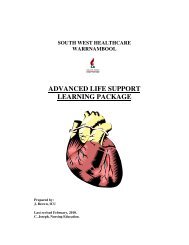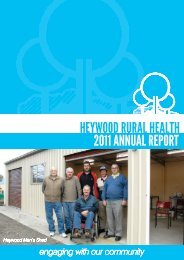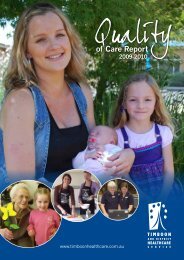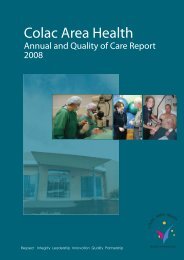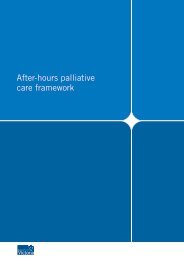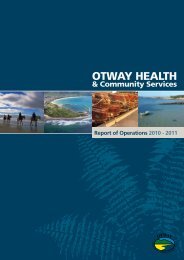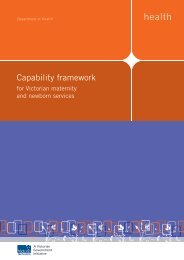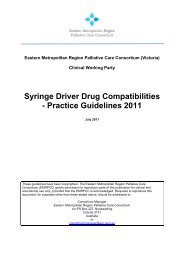Self Directed Learning Package - University of Queensland
Self Directed Learning Package - University of Queensland
Self Directed Learning Package - University of Queensland
- No tags were found...
Create successful ePaper yourself
Turn your PDF publications into a flip-book with our unique Google optimized e-Paper software.
33 • <strong>Self</strong> <strong>Directed</strong> <strong>Learning</strong> <strong>Package</strong> - Introductory Registered & Enrolled NurseSide effects <strong>of</strong> opioids can <strong>of</strong>ten be anticipated and treatedor avoidedChanging to another opioid or another route <strong>of</strong> administrationmay be necessary if still troublesome.Adjuvant analgesicsAlfred not only takes regular paracetamol and a weak opioid forhis pain, he is also prescribed a tricyclic antidepressant for hissciatic pain.This and other medications such as corticosteroids,anticonvulsants and benzodiazepines can supplement analgesicsor control symptoms that can exacerbate the perception <strong>of</strong> pain(e.g. inflammation, oedema, anxiety etc.)Myths about opioidsSpend time with the resident or family to dispel commonmyths about opioids. Sometimes residents, familymembers and even aged care staff may have concernsabout these medications.It is important to know that, when used correctly, opioidmedicines:Do not lead to addiction or dependenceOpioid medicines are not addictive when used for pain.Addiction only occurs when people have no pain andthey abuse opioid medicines.Do not hasten deathMorphine and other opioid medicines are for improvinglife — not hastening death. Some people fear that beingprescribed opioid medicines means that they’re closer tothe end. However, relieving pain changes the quality-<strong>of</strong>life— not its length.Do not cause terrible side-effectsAll medicines can have side effects. The side effects <strong>of</strong>opioid medicines (constipation, drowsiness, nausea, drymouth) are usually manageable.WriteKey PointThe type and cause <strong>of</strong> pain will determine which, ifany adjuvant medications are needed.Consult “Therapeutic Guidelines: Palliative Care”for additional and comprehensive prescribingrecommendations.Version 3 <strong>of</strong> these guidelines is included in thePA Toolkit.Document your actionsAvoid general statementsPOOR COMMUNICATIONGOOD COMMUNICATIONEvaluation <strong>of</strong> PRN analgesia‘Resident states pain has reduced to 2/10‘with effect’ or ‘effective’.score (was 5/10)’.Note to GP‘Alfred has a new pain in R) hip. Says‘Please review Alfred ASAP re pain in hip’. its severe, average 5/10, walking = 8/10.Wakens him at night if he rolls over in bed.Have tried hot packs, massage and regularsimple analgesia so far but no better’.ReviewEvaluate and reassess as necessaryThinking PointYou identified that Alfred has pain and conducted anassessment. You’ve updated his care plan to reinforceappropriate manual handling techniques and somemassage at night. This morning you discussed withAlfred’s GP about a regular analgesic order. Great job!Can you tick this <strong>of</strong>f your list? Not quite yet.There is an important question to answer:Did your strategies work?A formal scheduled review using the Modified Resident’s VerbalBrief Pain Inventory (M-RVBPI) or Abbey Pain Scale may bemore valuable than frequent, brief impressions. 2



